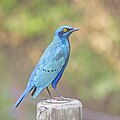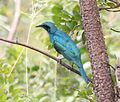| Lamprotornis | |
|---|---|

| |
| Greater blue-eared starling, L. chalybaeus normanni | |
| Scientific classification | |
| Domain: | Eukaryota |
| Kingdom: | Animalia |
| Phylum: | Chordata |
| Class: | Aves |
| Order: | Passeriformes |
| Family: | Sturnidae |
| Genus: | Lamprotornis Temminck, 1820 |
| Type species | |
| Turdus caudatus Statius Muller, 1776 | |
| Species | |
|
About 20, see text | |
Lamprotornis is a large genus of glossy-starlings all of which occur in Africa south of the Sahara. They have glossy blue or green upper parts, which is due to hollow melanin granules arranged in a single layer near the feather barbule's surface. This unique arrangement led to some glossy starlings formerly placed in the genus Spreo being transferred to Lamprotornis, since they shared this feature (but see also below).
The genus Lamprotornis was introduced by the Dutch zoologist Coenraad Jacob Temminck in 1820. The type species was subsequently designated as the long-tailed glossy starling.
The under parts of these species lack iridescence. They may be blue, purple, yellow or brown. Most Lamprotornis starlings have striking yellow or red irides and some have long tails.
These glossy starlings are found in a variety of habitats from forests to open woodland and gardens. They nest in tree holes, either natural, or made by woodpeckers or barbets, and some will use man-made structures. Most species are resident apart from seasonal or local movement, but Shelley's starling is migratory. Most species are gregarious outside the breeding season.
Lamprotornis glossy-starlings are omnivorous and mostly feed on the ground, although they will take fruit from trees. Some will feed on or near large mammals to find insects.
Species
The genus contains 23 species.
| Common Name | Scientific name | Image | Distribution |
|---|---|---|---|
| Cape starling | Lamprotornis nitens |  |
Southern Africa |
| Greater blue-eared starling | Lamprotornis chalybaeus |  |
Senegal east to Ethiopia and south through eastern Africa to northeastern South Africa and Angola |
| Lesser blue-eared starling | Lamprotornis chloropterus |  |
widespread in sub-Saharan Africa |
| Miombo blue-eared starling | Lamprotornis elisabeth |  |
Kenya to Zimbabwe and Botswana |
| Bronze-tailed starling | Lamprotornis chalcurus |  |
Senegal through Nigeria to South Sudan and Kenya |
| Splendid starling | Lamprotornis splendidus |  |
widespread in western and central Africa |
| Principe starling | Lamprotornis ornatus |  |
endemic to São Tomé and Príncipe |
| Emerald starling | Lamprotornis iris (former Coccycolius iris) |
 |
Guinea, Sierra Leone and Ivory Coast |
| Purple starling | Lamprotornis purpureus |  |
tropical Africa from Senegal and northern Zaire east to Sudan and west Kenya |
| Rüppell's starling | Lamprotornis purpuroptera |  |
Sudan, Eritrea and Ethiopia to Tanzania |
| Long-tailed glossy starling | Lamprotornis caudatus |  |
tropical Africa from Senegal east to Sudan. |
| Golden-breasted starling | Lamprotornis regius |  |
Ethiopia and Somalia to northern Tanzania |
| Meves's starling | Lamprotornis mevesii |  |
southern Africa |
| Burchell's starling | Lamprotornis australis |  |
southern Africa |
| Sharp-tailed starling | Lamprotornis acuticaudus |  |
southern central Africa |
| Superb starling | Lamprotornis superbus (former Spreo superbus) |
 |
eastern Africa |
| Hildebrandt's starling | Lamprotornis hildebrandti (former Notauges hildebrandti) |
 |
Ethiopia and Somalia to Kenya. |
| Shelley's starling, | Lamprotornis shelleyi |  |
eastern Africa |
| Chestnut-bellied starling | Lamprotornis pulcher (former Spreo pulcher) |

|
Burkina Faso and western Africa |
| Ashy starling | Lamprotornis unicolor (former Spreo unicolor) |
 |
Kenya and Tanzania |
| Pied starling | Lamprotornis bicolor (former Spreo bicolor) |
 |
South Africa, Lesotho and Swaziland |
| Fischer's starling | Lamprotornis fischeri (former Spreo fischeri) |
 |
southern Ethiopia and Somalia to eastern Kenya and Tanzania |
| White-crowned starling | Lamprotornis albicapillus (former Spreo albicapillus) |
 |
Djibouti, Ethiopia, Kenya, and Somalia. |
The limits of this genus have seen recent revision following phylogenetic analysis with molecular markers. For example, the black-bellied starling is now placed in a separate genus Notopholia. On the other hand, genera such as Coccycolius, Spreo and Compsarus were found nested in Lamprotornis and have been merged.
References
- "Sturnidae". aviansystematics.org. The Trust for Avian Systematics. Retrieved 2023-07-15.
- Temminck, Coenraad Jacob (1820). Manuel d'ornithologie, ou, Tableau systématique des oiseaux qui se trouvent en Europe (in French). Vol. Part 1 (2nd ed.). Paris: H. Cousin. p. 55 (LV).
- Dickinson, E.C.; Christidis, L., eds. (2014). The Howard & Moore Complete Checklist of the Birds of the World. Vol. 2: Passerines (4th ed.). Eastbourne, UK: Aves Press. p. 377. ISBN 978-0-9568611-2-2.
- ^ Gill, F.; Donsker, D.; Rasmussen, P., eds. (2024). "Nuthatches, Wallcreeper, treecreepers, spotted creepers, mockingbirds, starlings, oxpeckerss". IOC World Bird List. 14.2. Retrieved 1 January 2025.
- Wilkinson, R.; Brown, A. E. (1984). "Effect of Helpers on the Feeding Rates of Nestlings in the Chestnut-Bellied Starling Spreo pulcher". Journal of Animal Ecology. 53 (1): 301–310. Bibcode:1984JAnEc..53..301W. doi:10.2307/4358. ISSN 0021-8790. JSTOR 4358.
- Sweijd, Neville; Craig, Adrian J. F. K. (1991). "Histological Basis of Age-Related Changes in Iris Color in the African Pied Starling (Spreo bicolor)". The Auk. 108 (1): 53–59. ISSN 0004-8038. JSTOR 4088047.
- Zuccon, Dario; Cibois, Alice; Pasquet, Eric; Ericson, Per G. P. (2006-11-01). "Nuclear and mitochondrial sequence data reveal the major lineages of starlings, mynas and related taxa". Molecular Phylogenetics and Evolution. 41 (2): 333–344. Bibcode:2006MolPE..41..333Z. doi:10.1016/j.ympev.2006.05.007. ISSN 1055-7903. PMID 16806992.
- Feare, Chris & Craig, Adrian (1999): Starlings and Mynas. Princeton University Press. ISBN 0-7136-3961-X
- Zuccon, Dario; Cibois, Anne; Pasquet, Eric & Ericson, Per G.P. (2006): Nuclear and mitochondrial sequence data reveal the major lineages of starlings, mynas and related taxa. Molecular Phylogenetics and Evolution 41(2): 333–344. doi:10.1016/j.ympev.2006.05.007 PMID 16806992 (HTML abstract)
External links
 Media related to Lamprotornis at Wikimedia Commons
Media related to Lamprotornis at Wikimedia Commons Data related to Lamprotornis at Wikispecies
Data related to Lamprotornis at Wikispecies
| Taxon identifiers | |
|---|---|
| Lamprotornis | |